
The Arecaceae is a family of perennial, flowering plants in the monocot order Arecales. Their growth form can be climbers, shrubs, tree-like and stemless plants, all commonly known as palms. Those having a tree-like form are called palm trees. Currently, 181 genera with around 2,600 species are known, most of which are restricted to tropical and subtropical climates. Most palms are distinguished by their large, compound, evergreen leaves, known as fronds, arranged at the top of an unbranched stem, except for the Hyphaene genus, who has branched palms. However, palms exhibit an enormous diversity in physical characteristics and inhabit nearly every type of habitat within their range, from rainforests to deserts.
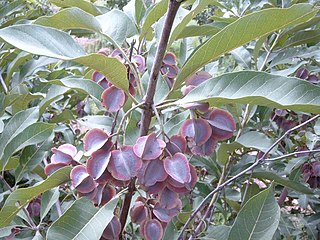
Combretum, the bushwillows or combretums, make up the type genus of the family Combretaceae. The genus comprises about 272 species of trees and shrubs, most of which are native to tropical and southern Africa, about 5 to Madagascar, but there are others that are native to tropical Asia, New Guinea and the Bismarck Archipelago, Australia, and tropical America. Though somewhat reminiscent of willows (Salix) in their habitus, they are not particularly close relatives of these.
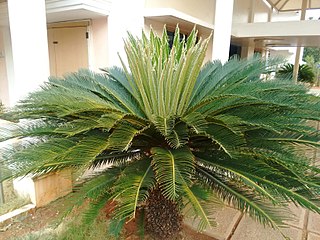
Cycas is a genus of cycad, and the only genus in the family Cycadaceae with all other genera of cycad being divided between the Stangeriaceae and Zamiaceae families. Cycas circinalis, a species endemic to India, was the first cycad species to be described in western literature, and is the type species of the genus.

Combretastatin is a dihydrostilbenoid found in Combretum caffrum.
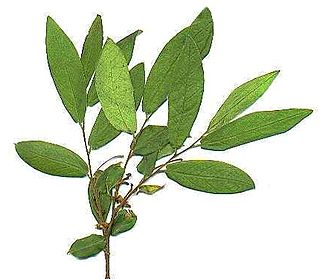
Combretum edwardsii, the Natal combretum or forest climbing bushwillow, is an uncommon forest plant endemic to the mistbelt region of eastern South Africa. It has a climbing habit and the stems may often lie prostrate on the forest floor or on cliff tops. As with some other Combretum species the leaves assume autumn colours before they are shed. The plant flowers in spring and the 4-winged fruits reach maturity in late summer.

Combretum padoides, the thicket bushwillow, occurs in the lowlands of tropical and south-eastern Africa. They grow in a range of habitats from muddy riverbanks to dry rocky hillsides. The mostly opposite oval leaves are carried on long slender branches. The trees or shrubs flower in profusion in mid-summer and the 4-winged fruits reach maturity from late summer to mid winter.

Combretastatin A-4 is a combretastatin and a stilbenoid. It can be isolated from Combretum caffrum, the Eastern Cape South African bushwillow tree or in Combretum leprosum, the mofumbo, a species found in Brazil.
Baphiopsis parviflora is an African species of flowering plants in the legume family, Fabaceae. It is the sole species in genus Baphiopsis. It is a shrub or tree which ranges from Cameroon to Tanzania and Angola.

Combretastatin A-1 is a combretastatin and a stilbenoid. It can be found in Combretum caffrum, the Eastern Cape South African Bushwillow tree.

Combretastatin B-1 is a combretastatin and a dihydrostilbenoid. It can be found in Combretum caffrum, the Eastern Cape South African bushwillow tree or in Combretum kraussii, the forest bushwillow.

Dihydrostilbenoids (bibenzyls) are natural phenols formed from the dihydrostilbene (bibenzyl) backbone.
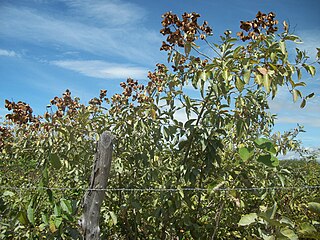
Combretum leprosum, the mofumbo in Portuguese and the asucaró in eastern Bolivian Spanish, is a plant species in the genus Combretum found throughout the Amazon Basin.

Combretum apiculatum is a species of tree in the family Combretaceae known by the common name red bushwillow. It is native to the mesic to semi-arid savanna regions of Africa, southwards of the equator.

Harpephyllum is a genus of trees in the family Anacardiaceae. The sole species is Harpephyllum afrum, a dioecious evergreen species from South Africa and Mozambique that is also cultivated. The fruit is edible.

Pleiocarpa mutica is a plant in the family Apocynaceae.
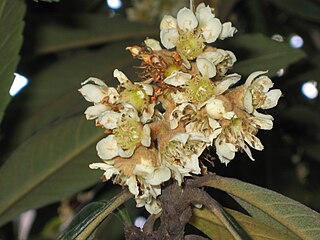
Rhaphiolepis bengalensis is a species of flowering plant in the family Rosaceae. R. bengalensis is a subtropical medium-sized tree, and is found in Asia, including in India at an elevation from 1,000 metres (3,300 ft) to 3,000 metres (9,800 ft). The species is rated least concern on the IUCN red list.
Strephonema pseudocola is a species of flowering plant in the family Combretaceae. It is a tree found in the forests of tropical West Africa. It was first described from the Ivory Coast.

Erica afra is a small tree, sometimes a shrub, that grows in riparian habitats and on forest edges and occurs from the Western Cape to the Drakensberg of KwaZulu-Natal and Lesotho. The tree's flowers look like bells. The tree's national tree number is 572.

Combretum zeyheri, the large-fruited bushwillow or Zeyher's bushwillow, is a species of flowering plant in the family Combretaceae, usually found growing on acidic or sandy soils in tropical African savannas. A small to medium-sized tree, its roots are used as a source of material for making baskets and as a traditional medicine for haemorrhoids.

Afrosciadium afrum is a member of the carrot family, Apiaceae. It is a perennial tuberous herb native to subtropical regions of South Africa and Lesotho.




















